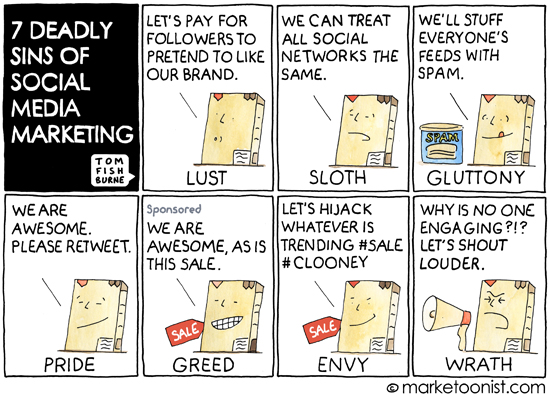
Courtesy of Tom Fishburne
Are you a frequent user of LinkedIn? I sure am.
A boon to professionals, managers, executives and entrepreneurs, LinkedIn is the number one social network for professionals and entrepreneurs looking to expand their networks.
LinkedIn allows us to connect to like-minded others. Through networking groups, we can find potential business partners, clients or suppliers.
HR managers and headhunters find LinkedIn an invaluable resource. At the click of few buttons, they can find a treasure trove of great candidates. Sales professionals also love LinkedIn for its ability to offer prospects right up their noses.
More recently, LinkedIn allowed virtually anybody to publish their ideas in the form of blog posts on Pulse. Such content not only democratizes influence – they help professionals from any industry to establish thought leadership and reputational capital.
Enter the LinkedIn Sinners
Unfortunately, like any social platform, LinkedIn can also be used in an inappropriate manner. Black hat digital marketers, con artists, and spammers use LinkedIn in ways that make me shudder.
Who are these clandestine characters?
Hard Sell Hucksters
Yes, I know that those properties in the London/ Manilla/ Melbourne are going to be the greatest investment opportunity this side of the Universe, but must you keep pushing it on your feed? If I want to see an advertisement, I’d much prefer to visit a dedicated property website or blog.
The only way to get people genuinely interested in your wares is to offer valuable and genuine advice first. Help people to discern between a good location and a poor location for a property. Work out the sums for them. See this example on buying a new condominium in Singapore.
Interest Group Spammers
OK, I confess that I was one of these nefarious persons who used to spam all the groups that I belong to. And then, I realised that nobody really gave a crap to those posts because I didn’t bother building relationships with them. Plus I made so much of a nuisance of myself that I was banned from a group or two!
Indeed, spamming is a no-no on LinkedIn. The law of reciprocity states that you ought to engage genuinely with the folks in the group first. Develop trust and likability. Offer useful insights and not just spamming of your links. I know because I’ve been there!
Serial News Jack Asses
I know I know. This is one of the cardinal rules of achieving “virality“. You ride on a trending topic, create content that hits all the right keywords and topics, and then voila! You’ve hit the attention jackpot.
An occasional post or two on this is OK. Heck, I use it myself too.
However, repeated abuse of this will make you look like an opportunist who doesn’t have a genuinely good product or service to offer. Especially if you can’t write to save your life!
Remember that you need to get back to the shore after surfing those trendy waves of publicity.
Dubious Product Pushers
Once, I was approached by a LinkedIn contact who told me to give him my contact number. His profile looked pretty decent, and he had a nice website to boot.
Foolishly, I agreed to do so.
When we chatted, he shared about his wonderful business opportunity and how I could play a mentoring role in it. However, he refused to email me anything and insisted that we meet face-to-face. Naturally, I turned it down, having smelt a phis…. err… fish!
Masquerading yourself on LinkedIn is a big no-no. If you wish to offer a business proposition, do be open and candid about it rather than hide behind layers of pretense.
Phantom Bank Employees
How many of you have been approached by an “accountant” or “bank officer” from Lloyd’s Bank? Put up your hands. Yes, there seem to be an endless stream of them, and we all know that they are 100% fake.
It is amazing how so many of these con artists have migrated to LinkedIn, proffering to help you gain access to the US$3 million left behind by a wealthy Nigerian widow. Come on, its 2015 already!
Spam Bots
Do you know that there are folks who love to cut-and-paste the same comments on other people’s posts? What’s funny is that these generic comments often have a “call to action” which includes something like a “follow me back” tactic, as well as words like “Awesome!”, “Great Post!” or something like that.
I believe that the best way to interact and engage is to be real. Put in the effort to contribute something noteworthy in the comment box. Minimally, at least, make some reference to the subject being shared.
* Admittedly, I do become Mr Roboto every now and then. Fortunately, I’ll jolt myself back to being a genuine, breathing, flesh and blood human being thereafter.
Celebrity Masqueraders
Last, but certainly not least, there cloak and dagger identity thieves who impersonate celebrities.
I’ve been approached twice before – once by a “Pastor Joseph Prince” and another by former Thai PM “Yingluck Shinawatra”. These insidious imitators made use of publicly available information to populate their profiles. Fortunately, these crooks were sniffed out, and their profiles are no longer around.
Beware of promises by actors, politicians, religious leaders which look too good to be true. In all likelihood, they are probably not the real McCoys.
Are there other nefarious characters whom you have come across on LinkedIn?
